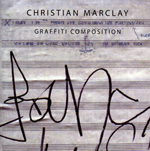|
|
 |
Dusted Reviews
Artist: Christian Marclay Album: Graffiti Composition Label: Dog W/A Bone Review date: Aug. 17, 2010 |

|
|
|
 |
The rules of attribution have been stretched, broken and ignored so frequently in the last century that contemporary instances likely don’t register a second thought from most. That Graffiti Composition is released solely under Christian Marclay’s name, however, masks a more involved evolution that most from inception to execution. The citizens and visitors of Berlin circa 1996 wrote the score, Elliott Sharp selected the material to be played, directed its interpretation, and joined Melvin Gibbs, Mary Halvorson, Vernon Reid and Lee Ranaldo in its actual performance. Marclay is the author of the work, to be sure, the source’s of Graffiti Composition‘s conceptual birth, but the presence of Sharp and his guitarist cohorts is the more palpable on this disc. Marclay, a progenitor of turntable experimentalism and noted visual artist, is no stranger to the use of others’ musical products in his own work, though there’s some turnabout here, with the album featuring an almost complete surrender of control in the name of seeing a work through its intended conclusion. Projects like Record Without a Cover and Footsteps show that Marclay’s long been interested in less predictable modes of music making, and this is another example of taking chances by opting for a process that can be quite literally out of his hands.
Graffiti Composition‘s score was selected from thousands of pages of sheet music put up around Berlin in 1996. The sheets were photographed after passersby drew on, painted or plastered other posters over the original staff lines, and whittled down to a collection of 150, some with scrawled text and unplayable melodies, others simply tagged or drawn over. Marclay allowed Sharp and his quintet to interpret this nonconventional notation however they chose, and the results are predictably varied. Nimble runs up and down the fretboard meet with glacial slabs of distortion, and Sharp’s mission to select axe-wielders with varied skill sets pays off in 40 minutes of guitar music that is many-limbed and multifarious. Although guesses can be made as to who’s playing what, Graffiti Composition, even during solos, is a largely anonymous recording to all but those who were at the Museum of Modern Art in September 2006 to see it performed. Sharp’s score was divided into predefined solos and collaborative playing navigated via visual cues, leaving each player space to stretch out without accompaniment, as well as contribute to the chaotic constructions of unison playing. Distortion hangs heavily over the proceedings, while effects and electronics warp and transform the sounds of the amplified strings. That Graffiti Composition is guitar music is rarely in doubt, but there’s little fodder for lovers of traditional technical wizardry or straight-ahead, unadorned playing.
When Graffiti Composition is at full steam, the genesis of the pieces is easily forgotten, Marclay’s interesting experiment in citywide composition an afterthought amidst what could be simply an impromptu session amongst some of New York’s finest. Anyone with a yen for the brand of improvised guitar alchemy that finds its epicenter on the island of Manhattan will know what to expect, while some fans of Christian Marclay may appreciate Graffiti Composition‘s raison d’etre more than the album’s actual content. Simply put, the playful inventiveness of the over-arching work doesn’t always shine through in the performance.
Graffiti Composition was initiated in 1996, performed in 2006, and has finally found its way to the marketplace in 2010. The disc isn’t the revelation that such a gestation period might suggest, but the dissonance that exists between its concept and execution is more of an occasional disappointment than damning blow.
By Adam Strohm
|







